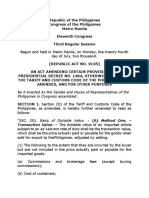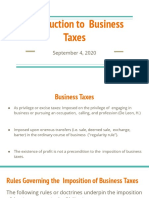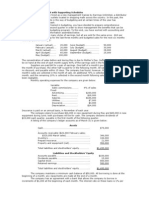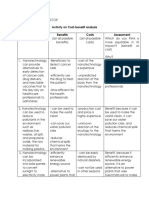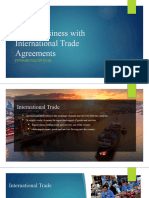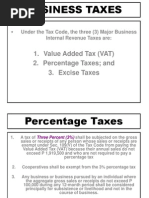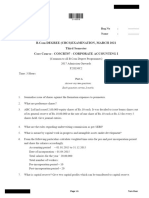0 ratings0% found this document useful (0 votes)
270 viewsTax Vat
Tax Vat
Uploaded by
kmabcdeValue Added Tax (VAT) is a form of indirect tax levied on the sale of goods and services and imports in the Philippines. Those required to file VAT returns include any person or entity with actual gross sales over 1.9 million pesos in a 12-month period, those who failed to register as required, importers, and professional practitioners with over 1.5 million pesos in annual fees. Professional practitioners subject to VAT include certified public accountants, insurance agents, and those who passed government exams like lawyers, doctors, and engineers.
Copyright:
© All Rights Reserved
Available Formats
Download as PPT, PDF, TXT or read online from Scribd
Tax Vat
Tax Vat
Uploaded by
kmabcde0 ratings0% found this document useful (0 votes)
270 views67 pagesValue Added Tax (VAT) is a form of indirect tax levied on the sale of goods and services and imports in the Philippines. Those required to file VAT returns include any person or entity with actual gross sales over 1.9 million pesos in a 12-month period, those who failed to register as required, importers, and professional practitioners with over 1.5 million pesos in annual fees. Professional practitioners subject to VAT include certified public accountants, insurance agents, and those who passed government exams like lawyers, doctors, and engineers.
Original Description:
tax
Original Title
TAX-VAT
Copyright
© © All Rights Reserved
Available Formats
PPT, PDF, TXT or read online from Scribd
Share this document
Did you find this document useful?
Is this content inappropriate?
Value Added Tax (VAT) is a form of indirect tax levied on the sale of goods and services and imports in the Philippines. Those required to file VAT returns include any person or entity with actual gross sales over 1.9 million pesos in a 12-month period, those who failed to register as required, importers, and professional practitioners with over 1.5 million pesos in annual fees. Professional practitioners subject to VAT include certified public accountants, insurance agents, and those who passed government exams like lawyers, doctors, and engineers.
Copyright:
© All Rights Reserved
Available Formats
Download as PPT, PDF, TXT or read online from Scribd
Download as ppt, pdf, or txt
0 ratings0% found this document useful (0 votes)
270 views67 pagesTax Vat
Tax Vat
Uploaded by
kmabcdeValue Added Tax (VAT) is a form of indirect tax levied on the sale of goods and services and imports in the Philippines. Those required to file VAT returns include any person or entity with actual gross sales over 1.9 million pesos in a 12-month period, those who failed to register as required, importers, and professional practitioners with over 1.5 million pesos in annual fees. Professional practitioners subject to VAT include certified public accountants, insurance agents, and those who passed government exams like lawyers, doctors, and engineers.
Copyright:
© All Rights Reserved
Available Formats
Download as PPT, PDF, TXT or read online from Scribd
Download as ppt, pdf, or txt
You are on page 1of 67
Value Added Tax (VAT)
Value-Added Tax (VAT) is a form of
sales tax. It is a tax on consumption
levied on the sale of goods and services
and on the imports of goods into the
Philippines. It is an indirect tax, which
can be passed on to the buyer.
Value Added Tax (VAT)
Who Are Required To File VAT Returns
Every person or entity who in the course of his trade or
business, sells or leases goods, properties and services
subject to VAT, if the aggregate amount of actual gross
sales or receipts exceed One Million Nine Hundred
Nineteen thousand Five Hundred Pesos (P 1,919,500.00)
for any twelve month period
A person required to register as VAT taxpayer but failed
to register
Value Added Tax (VAT)
Who Are Required To File VAT Returns
A person who imports goods
Professional practitioners
Professional Practitioners (PPs) are formerly classified as non-VAT taxpayers
and were exempt from the VAT and Percentage taxes under Section 109 of the
Tax Code until December 31, 2002.
Prior to this date, they were subject only to Income Tax. Effective January 1,
2003, however, by virtue of RA 7716 and 9010, services of Professional
Practitioners are also subject to either VAT or 3% Percentage Tax.
Starting 2005 services of Professional Practitioners are subject to VAT if gross
professional fees exceed P1.5 million for a 12-month period and subject to 3%
Percentage Tax if gross professional fees total P1.5 million and below for a 12month
Value Added Tax (VAT)
Who Are Considered Professional Practitioners?
"Professional Practitioners" include the following:
Certified Public Accountants
Insurance Agents (Life & Non-life)
Other Professional Practitioners required to pass the
government examination (Lawyers, Doctors, Engineers,
Architects, etc.)
Others (Professional entertainers, Professional Athletes,
Licensed Customs Brokers, etc.)
Value Added Tax (VAT)
Frequently Asked Questions about the VAT
1) What is Output Tax"?
Output tax means the VAT due on the sale,
lease or exchange of taxable goods or properties
or services by any person registered or required
to register under section 236 of the Tax Code.
Value Added Tax (VAT)
Frequently Asked Questions about the VAT
2) What is Input Tax"?
Input tax means the VAT paid by a VATregistered person in the course of his trade or
business on importation of goods or local
purchase of goods or services, including lease or
use of property, from a VAT-registered person.
It shall also include the transitional input tax
determined in accordance with Section 111 of the
Tax Code
Value Added Tax (VAT)
Frequently Asked Questions about the VAT
3) What comprises Goods or Properties?
The term "goods or properties" shall mean all
tangible and intangible objects, which are
capable of pecuniary estimation and shall
include:
a. Real properties held primarily for sale to
customers or held for lease in the ordinary
course of trade or business
Value Added Tax (VAT)
b. The right or the privilege to use patent,
copyright, design or model, plan, secret
formula or process, goodwill, trademark,
trade brand or other like property or right
c. The right or the privilege to use in the
Philippines any industrial, commercial or
scientific equipment
Value Added Tax (VAT)
d. The right or the privilege to use motion
picture film, films, tapes and discs
e. Radio, television, satellite transmission and
cable television time
Value Added Tax (VAT)
4) What comprises "sale or exchange of services"?
The term "sale or exchange of services" means
the performance of all kinds of services in the
Philippines for others for a fee, remuneration
or consideration, including those performed or
rendered by the following:
a. Construction and service contractors
b. Stock, real estate, commercial, customs
and immigration brokers
Value Added Tax (VAT)
c. Lessors of property, (personal or real)
d. Warehousing services
e. Lessors or distributors of cinematographic
films
f. Persons engaged in milling, processing,
manufacturing or repacking goods for
others
Value Added Tax (VAT)
g. Proprietors, operators or keepers of hotels,
motels, resthouses, pension houses, inns,
resorts
h. Proprietors or operators of restaurants,
refreshment parlors, cafes and other
eating places, including clubs and caterers
i. Dealers in securities
j. Lending investors
Value Added Tax (VAT)
k. Transportation contractors on their
transport of goods or cargoes, including
persons who transport goods or cargoes
for hire and other domestic common
carriers by land, air and water relative to
their transport of goods or cargoes
l. Services of franchise grantees of telephone
and telegraph, radio and television
broadcasting and all other franchise
grantees except those under Section 119 of
the Tax Code
Value Added Tax (VAT)
m. Services of non-life insurance companies
(except their crop insurances), including
surety, fidelity, indemnity and bonding
companies
n. Similar services regardless of whether or
not the performance thereof calls for the
exercise or use of the physical or mental
faculties
Value Added Tax (VAT)
5) What is included in the phrase Sale or
Exchange of Services"
The phrase "sale or exchange of services shall
include: shall include:
a. The lease or the use of or the right or
privilege to use any copyright, patent, design
or model, plan, secret formula or process,
goodwill, trademark, trade brand or other
like property or right
Value Added Tax (VAT)
b. The lease or the use of, or the right to use
of any industrial, commercial or scientific
equipment
c. The supply of scientific, technical, industrial
or commercial knowledge or information
d. The supply of any assistance that is ancillary
and subsidiary to and is furnished as a means
of enabling the application or enjoyment of
any such property, or right or any such
knowledge or information
Value Added Tax (VAT)
e. The supply of services by a nonresident
person or his employee in connection with the
use of property or rights belonging to, or the
installation or operation of any brand,
machinery or other apparatus purchased
from such non-resident person
f. The supply of technical advice, assistance or
services rendered in connection with
technical management or administration of
any scientific, industrial or commercial
undertaking, venture, project or scheme
Value Added Tax (VAT)
g. The lease of motion picture films, films, tapes
and discs
h. The lease or the use of or the right to use
radio, television, satellite transmission and
cable television time
Value Added Tax (VAT)
6) What is a zero-rated sale?
It is a sale, barter or exchange of goods,
properties and/or services subject to 0%
VAT pursuant to Sections 106 (A) (2) and
108 (B) of the Tax Code.
Value Added Tax (VAT)
7) What transactions are considered as zero-rated
sales?
The following services performed in the Philippines by VAT-registered persons shall be
subject to zero percent (0%) rate:
Value Added Tax (VAT)
a. Processing, manufacturing or repacking
goods for other persons doing business
outside the Philippines which goods are
subsequently exported where the services are
paid for in acceptable foreign currency and
accounted for in accordance with the rules
and regulations of the Bangko Sentral ng
Pilipinas (BSP)
Value Added Tax (VAT)
b. Services other than those mentioned in the
preceding paragraph, the consideration for
which is paid for in acceptable foreign
currency and accounted for in accordance
with the rules and regulations of the Bangko
Sentral ng Pilipinas (BSP)
c. Services rendered to persons or entities whose
exemption under special laws or international
agreements to which the Philippines is a
signatory effectively subjects the supply of
such services to zero percent (0%) rate
Value Added Tax (VAT)
d. Services rendered to vessels engaged exclusively in international shipping
e. Services performed by subcontractors and/or
contractors in processing, converting, or
manufacturing goods for an enterprise
whose export sales exceeds seventy
percent (70%) of total annual
production
Value Added Tax (VAT)
8) What Sales by a VAT-Registered Persons are
subject to 0% rate?
The following sales by VAT-registered persons
shall be subject to zero percent (0%) rate:
a. Sale of goods which are directly shipped by
a VAT-registered resident to a place outside
the Philippines
Value Added Tax (VAT)
b. Sale of goods which are considered as
"deemed" export sales by a VAT-registered
person to certain entities who are also
residents of the Philippines:
Sales to export-oriented enterprises which the Code
considers as export sales at the level of the supplier
of raw materials
Sales of gold to the Bangko Sentral ng Pilipinas
Sales considered as exportation of goods under a
special law such as Executive Order No. 226
(Omnibus Investments Code of 1987) and Republic
Act No. 7916 (PEZA Law)
Value Added Tax (VAT)
c. Foreign currency denominated sales of goods
d. Sales to entities, the exemption of which,
under a special law or an international
agreement with the Government of the
Philippines, effectively zero rates such sales
Value Added Tax (VAT)
9) What transactions are considered as
Transaction Deemed Sales?
The following transactions are considered as
deemed sales:
a. Transfer, use or consumption, not in the
course of business, of goods or properties
originally intended for sale or for use in the
course of business
Value Added Tax (VAT)
b. Distribution or transfer to:
- Shareholders or investors as share in the
profits of the VAT-registered person; or
- Creditors in payment of debt
c. Consignment of goods if actual sale is not
made within sixty (60) days following the
date such goods were consigned
d. Retirement from or cessation of business,
with respect to inventories of taxable goods
existing as of such retirement or cessation
Value Added Tax (VAT)
10) What is VAT-exempt sale?
It is a sale of goods, properties or service and
the use or lease of properties which is not
subject to output tax and whereby the buyer
is not allowed any tax credit or input tax
related to such exempt sale.
Value Added Tax (VAT)
11) What are the VAT-exempt transactions?
a. Sale of non-food agricultural, marine and
forest products in their original state by the
primary producer or owner of the land
where the same were produced
b. Sale of cotton and cotton seeds in their
original state and copra
Value Added Tax (VAT)
c. Sale or importation of agricultural and
marine food products in their original state,
livestock and poultry of a kind generally
used as, or yielding or producing foods for
human consumption and breeding stock and
genetic materials thereof
Value Added Tax (VAT)
d. Sale or importation of fertilizers; seeds,
seedlings and fingerlings; fish, prawn, livestock and poultry feeds, including ingredients
whether locally produced or imported, used
in the manufacture of finished feeds (except
specialty feeds for race horses, fighting cocks,
aquarium fish, zoo animals and other animals
generally considered as pets)
Value Added Tax (VAT)
e. Sale, Importation or lease of passenger and/or
cargo vessels and aircraft, including engine,
equipment and spare parts of said vessel to be
used by the importer himself as operator thereof
Value Added Tax (VAT)
f. Importation of personal and household effects
belonging to residents of the Philippines
returning from abroad and nonresident
citizens coming to resettle in the Philippines;
Provided, that such goods are exempt from
customs duties under the Tariff and Customs
Code of the Philippines
Value Added Tax (VAT)
g. Importation of professional instruments and implements,
wearing apparel, domestic animals, personal household
effects (except any vehicle, vessel, aircraft, machinery,
other goods for use in the manufacture and merchandise
of any kind in commercial quantity) belonging to persons
coming to settle in the Philippines, for their own use and
not for sale, barter or exchange, accompanying such
persons, or arriving within ninety (90) days before or
after their arrival, upon the production of evidence
satisfactory to the CIR, that such persons are actually
coming to settle in the Philippines and that the change
of residence is bona fide
Value Added Tax (VAT)
h. Services subject to percentage tax
i. Services by the agricultural contract growers
and milling for others of palay into rice, corn
into grits, and sugar cane into raw cane sugar
j. Medical, dental, hospital and veterinary services except those rendered by professionals
Value Added Tax (VAT)
k. Educational services rendered by private
educational institutions, duly accredited by
the Dept. of Education Culture and Sports
(DECS), and Commission on Higher Education (CHED), and those rendered by the
government educational institutions
Value Added Tax (VAT)
l. Services rendered by individuals pursuant
to an employer-employee relationship
m. Services rendered by regional or area headquarters established in the Philippines by
multinational corporations which act as
supervisory communications and coordinating
centers for their affiliates, subsidiaries or
branches in the Asia-Pacific Region and do
not earn or derive income from the Phils.
Value Added Tax (VAT)
n. Transactions which are exempt under
international agreements to which the
Philippines is a signatory, or under special
laws, except those under the following laws:
P.D. No. 66 - Export Processing Zone Authority
(EPZA) registered firms
P.D. No. 529 - Petroleum Exploration
Concessionaires under the Petroleum Act of 1949
P.D. No. 1590 - Philippine Airlines (PAL) relative to
domestic transport of goods or cargoes
Value Added Tax (VAT)
o. Sales by agricultural cooperatives duly
registered with the Cooperative Development
Authority (CDA) to their members as well as
sale of their produce, whether in its original
state or processed form, to non-members;
their importation of direct farm inputs,
machineries and equipment, including spare
parts thereof, to be used directly and
exclusively in the production and/or
processing of their produce
Value Added Tax (VAT)
p. Gross receipts from lending activities by credit or
multi-purpose cooperatives duly registered with the
Cooperative Development Authority (CDA) whose
lending operation is limited to their members
q. Sales by non-agricultural, non-electric and non-credit
cooperatives duly registered with the Cooperative
Development Authority: Provided, that the share
capital contribution of each member does not exceed
Fifteen Thousand Pesos (P 15,000) and regardless of
the aggregate capital and net surplus ratably distributed among the members
r. Export sales by persons who are not VAT-registered
Value Added Tax (VAT)
s. Sale of real properties utilized for low-cost
housing as defined by R.A. No. 7979,
otherwise
known as the Urban Development Housing Act of
1992 and other related laws, such as R.A. No. 7835
and R.A. No. 8763
wherein the price ceiling per
unit is
P1,500,000.00 or as may from time
to time be determined by the Housing and Urban
Development Coordinating Council (HUDCC)
and the National Economic Development
Authority (NEDA);
Value Added Tax (VAT)
i. Sale of real properties utilized for socialized
housing defined under R.A. No. 8763, wherein the
price ceiling per unit is P225,000.00 or as may from
time to time be determined by the HUDCC and the
NEDA and other related laws;
ii. Sale by real estate dealers and/or lessors of house
and lot and other residential dwellings valued at
P1,500,000.00 and below the amount shall be
adjusted to its present value using the Consumer Price
Index as published by the National Statistics
Office
(NSO).
Value Added Tax (VAT)
t. Lease of a residential unit with a monthly rental per
unit not exceeding Ten Thousand Pesos (P10,000.00),
regardless of the amount of aggregate rentals received
by the lessor during the year: Provided, that the
exemption likewise applies to lease of residential units
where the monthly rental per unit exceeds P 10,000.00
but the aggregate rentals of the lessor during the year
do not exceed P 1,500,000.00: the amount of P10,000.00
shall be adjusted to its present value using the
Consumer Price Index, as published by the NSO;
Value Added Tax (VAT)
u. Sale, importation, printing or publication of
books and any newspaper, magazine, review
or bulletin which appears at regular intervals
with fixed prices for subscription and sale and
which is not devoted principally to the publication of paid advertisements
Value Added Tax (VAT)
v. Sale or lease of goods or properties or the
performance of services other than the transactions mentioned in the preceding paragraphs, the gross annual sales and/or receipts
does not exceed the amount of P1,500,000.00:
w. Services of banks, non-bank financial
intermediaries performing quasi-banking
functions, and other non-bank financial
intermediaries;
Value Added Tax (VAT)
12)
What are the Applicable VAT Rates?
(a) Twelve Percent (12%);
(b) Zero Percent (0%);
(c) Seven Percent (7%)
Value Added Tax (VAT)
13)
What are the Tax Formula for VAT?
The General Formula for VAT Payable is:
Output Tax
P XXX
Less: Input Tax
XXX
VAT Payable
P XXX
=====
Value Added Tax (VAT)
14) Withholding Value Added Tax
The Government or any of its political subdivisions,
instrumentalities or agencies, including governmentowned and controlled corporations shall, before making
payment on account of services rendered or for its
purchase of goods from sellers of services of goods
which are subject to the VAT, deduct and withhold a
Final Withholding VAT at the rate of Seven Percent (7%)
of the gross payment.
The contract price of the services rendered by the
contractor shall no longer be declared in the Monthly
VAT Declaration or Quarterly VAT Return
Value Added Tax (VAT)
15) What are the Deadlines of Filing of the Monthly
VAT Declaration and Quarterly VAT Returns
and the Applicable VAT Forms?
For Monthly VAT Declaration:
20 days after the end of the month
BIR Form 2550M Monthly VAT
Declaration
For Quarterly VAT Return:
25 days after the end of each quarter
BIR Form 2550Q Quarterly VAT Return
Value Added Tax (VAT)
16. The Formula for Sale of Services
Output Tax (Gross Receipts x 12%)
P XXX
Less: Input Taxes
VAT paid on local purchases and importation of goods
For materials, supplied with the sale of service P XXX
For use as supplies in the course of business
XXX
For use in the course of trade or business for
which deduction for depreciation (or
amortization is allowed, except
automobile, aircraft and yachts)
XXX
VAT paid on the purchase of real property
XXX
VAT paid on purchase of services
XXX
Transitional Input Tax
XXX
XXX
VAT Payable
P XXX
======
Value Added Tax (VAT)
17. What does Gross Receipts mean?
The term gross receipts means cash or its cash
equivalent actually or constructively received
(not including the VAT) as:
(a) payment on the contract price, compensation, service fee, rental or royalty;
(b) payment for materials, supplied with the
services; and
(c) Deposits or advanced payments on the
contract for services
Value Added Tax (VAT)
Illustrative Problem - 1
CarCare Shop is a car repair shop furnishing labor only or
both parts and labor. CareCare Shop had the following data
for August 2010 (all information are exclusive of VAT):
Amounts received as advances on
car to be repaired and repainted
P 11,000
Amounts received for cars repaired,
repainted, finished and delivered
to owners:
For Labor
175,000
For Parts (purchased from a
VAT registered supplier)
33,000
Amounts paid to machine shop
44,000
Amount paid to suppliers of paints
55,000
Value Added Tax (VAT)
Solution - 1
OUTPUT TAX
Cash received as advances (P 11,000x 12%)
P 1,320
Cash received for completed jobs for
Labor (P 175,000 x 12%)
21,000
Parts (P 33,000 x 12%)
3,960
Total Output Tax
26,280
Less: INPUT TAX
On Parts purchased (P 33,000 x 12%) P 3,960
On Machine Shop
(P 44,000 x 12%)
5,280
On Paints purchased (P 55,000 x 12%)
6,600 15,840
VAT Payable
P 10,440
Value Added Tax (VAT)
Illustrative Problem - 2
Mr. Q is a CPA in the practice of public accounting and is a VATregistered taxpayer. Data for August 2010 (all information are
exclusive of VAT):
Professional Fees received, net of 10%
withholding income tax
P 180,000
Accounts receivable from clients
300,000
Reimbursements received on advances to clients:
Expenses chargeable to clients, billed to client
20,000
Expenses chargeable to clients, billed to Mr. Q
6,000
Purchase of Computer
70,000
Purchase of Office Supplies
2,500
Payment for Utilities (PLDT/Meralco)
15,000
Payment for Salaries of employees
25,000
Other Expenses:
Paid to VAT taxpayers
3,000
Paid to Non-VAT taxpayers
8,000
Value Added Tax (VAT)
Solution - 2
OUTPUT TAX
On Professional Fees received [(P 180,000/90%) x 12%]
P 24,000
On reimbursement received from clients for expenses
chargeable to Clients, billed to Mr. Q (P 6,000 x 12%)
720
Total Output Tax
24,720
Less: INPUT TAX
On expenses chargeable to client, billed to Mr. Q P 720
Purchase of Computer (P 70,000 x 12%)
8,400
Purchase of Office Supplies (P 2,500 x 12%)
300
Payment for Utilities (P 15,000 x 12%)
1,800
Payment for other expenses of operations paid to
VAT taxpayers (P 3,00 x 12%)
360
11,580
VAT Payable
P 13,140
Value Added Tax (VAT)
18. The Formula for Sale of Goods or Properties is:
Output Tax (Gross Selling Price x 12%)
P XXX
Less: Input Taxes
VAT paid on local purchases and importation of goods
For sale; or
P XXX
For conversion into or intended to form
part of a finished product for sale,
including packaging materials
XXX
For use as supplies in the course of business
XXX
For use in the course of trade or business for
which deduction for depreciation (or
amortization is allowed, except
automobile, aircraft and yachts)
XXX
VAT paid on the purchase of real property
XXX
VAT paid on purchase of services
XXX
Transitional Input Tax
XXX
XXX
VAT Payable
P XXX
======
Value Added Tax (VAT)
Illustrative Problem
Mr. X, a VAT-registered taxpayer, total sales for the month of August
2010 was P 1,500,000 (VAT not included). For the same period,
purchases (VAT not included), were:
Goods for sale from A Co., a VAT taxpayer
P 300,000
Goods for sale, from B Co., a Non-VAT taxpayer
200,000
Supplies, from C Co., a VAT taxpayer
50,000
Services from D Co., a VAT taxpayer
60,000
Office equipment, from E Co., a VAT taxpayer
40,000
Real property for use in business, from F Co.,
a VAT taxpayer
500,000
Rent paid to G Co., a VAT Taxpayer
50,000
Value Added Tax (VAT)
Solution
OUTPUT TAX Sales (P 1,500,000 x 12%)
P 180,000
Less: INPUT TAXES
On goods purchased from A Co. (P 300,000 x 12%)
36,000
On Supplies purchased from C Co. (P 50,000 x 12%)
6,000
On Services purchased from D Co. (P 60,000 x 12%)
7,200
On Office equipment purchased from E Co.
(P 40,000 x 12%)
4,800
On Real Property purchased from F Co.
(P 500,000 x 12%)
60,000
On Rental paid to G Co. (P 50,000 x 12%)
6,000
Total Input Taxes
120,000
VAT Payable
P 60,000
Value Added Tax (VAT)
19. What is a Presumptive Input Tax?
Persons engaged in the processing of sardines, mackerel
and milk, and in the manufacturing of refined sugar,
cooking oil, and packed noodle-based instant meals, shall
be allowed a presumptive input tax, equivalent to four
percent (4%) of the gross value in money of their
purchases of primary agricultural products which are used
as inputs to their production
Value Added Tax (VAT)
Processing shall mean pasteurization, canning and
activities which through physical or chemical process
alters the exterior texture or form or inner substance
of a product in such a manner as to prepare it for
special use to which it could not have been put in its
original from and condition
Value Added Tax (VAT)
Illustrative Example
Dyesebel Foods Corp. purchased sardines from fishermen
and processes them into canned sardines. During the month
of August 2010, the following sales and purchases (VAT not
included) were made:
Sales
P 400,000
Fish from fishermen
100,000
Tin cans from Lata Co.
20,000
Tomato paste (in cans)
5,000
Olive Oil (in bottles)
2,500
Pepper from farmers
1,800
Paper labels from Tatak Co.
500
Value Added Tax (VAT)
Solution
Output Tax (P 400,000 x 12%)
P 48,000
Less: INPUT TAXES
Actual Input Tax on Purchases
On Tin cans (P 20,000 x 12%) P 2,400
On Tomato Paste (P 5,000 x 12%)
600
On Olive Oil (P 2,500 x 12%)
300
On Paper Labels (P 500 x 12%)
60
Presumptive Input Tax
On Pepper ( 1,800 x 4%)
72
3,432
VAT Payable
P 44,566
Value Added Tax (VAT)
20. Transitional Input Tax
A person who becomes liable to VAT or any person who
elects to be a VAT registered person shall, be allowed
input tax on his beginning inventory of goods, materials
and supplies equivalent to two percent (2%) of the value
of such inventory or the actual VAT paid on such goods,
materials and supplies, whichever is higher.
The amount allowable shall be credited against the
Output Tax.
Value Added Tax (VAT)
21. Example - Transitional Input Tax
Mr. A, owner of a trading firm, initially registered as a non-VAT taxpayer
paying the 3% percentage tax. On the following following year he
registered as a VAT taxpayer because his sales in the previous year
exceeded P 1,500,000. At the beginning of the year he has the following
inventories:
Merchandise inventory. . . . . . . . . . . . . . . . . . . . . . . . .P 450,000
Store and Office supplies inventory. . . . . . . . . . . . . . . 100,000
Actual Input Tax Paid on the Inventories. . . . . . . . . P 66,000
How much is the Allowed Transitional Input Tax?
Value Added Tax (VAT)
22. Solution - Transitional Input Tax
Merchandise inventory. . . . . . . . . . . . . . . . . . . . .P 450,000
Store and Office supplies inventory. . . . . . . . . . . 100,000
Total Inventories of merchandise and supplies P 550,000
Multiply by Transitional Input Tax Rate. . . . .
2%
Transitional Input Tax. . . . . . . . . . . . . . . . . . . . .P 11,000
Actual Input Tax . . . . . . . . . . . . . . . . . . . . . . . . . P 66,000
Allowed. . . . . . . . . . . . . . . . . . . . . . . . . . . . . . . . . P 66,000
=======
Value Added Tax (VAT)
23. Excess Input Tax Carry Over
In cases, where the Total Input Taxes exceed the Total
Output Tax for a given period, only the amount of input
taxes shall be applied to the Total Output Tax.
The Excess Input Tax shall be used and applied in the
succeeding taxable period.
Should there be an excess input tax in the first month of a
quarter, and again an excess input tax in the second month
of the same quarter, while the excess input tax of the first
month is carried over to the second month, the excess input
tax of the second month is not carried over to the third
month.
You might also like
- Ra 9135Document20 pagesRa 9135Daley CatugdaNo ratings yet
- Strategic ManagmenttDocument19 pagesStrategic ManagmenttAsif AliNo ratings yet
- Company Profile GlobeDocument15 pagesCompany Profile GlobekmabcdeNo ratings yet
- Shell Case StudyDocument1 pageShell Case StudykmabcdeNo ratings yet
- Ias 16Document3 pagesIas 16Jhonalyn ZonioNo ratings yet
- Estate and Donors Tax in Re TRAIN LAWDocument8 pagesEstate and Donors Tax in Re TRAIN LAWRona RososNo ratings yet
- Taxn03B: Transfer and Business TaxesDocument18 pagesTaxn03B: Transfer and Business TaxesKerby GripoNo ratings yet
- Exempt Sales - NotesDocument28 pagesExempt Sales - NotesSunny DaeNo ratings yet
- Vat On Sale of Services AND Use or Lease of PropertyDocument67 pagesVat On Sale of Services AND Use or Lease of PropertyZvioule Ma FuentesNo ratings yet
- Explain The Relationship Between Risk and ReturnDocument2 pagesExplain The Relationship Between Risk and ReturnKristine Claire PangandoyonNo ratings yet
- VAT Concepts Tax 321Document28 pagesVAT Concepts Tax 321justineNo ratings yet
- Chapter 2. The Time Value of Money: (Section 2.2)Document35 pagesChapter 2. The Time Value of Money: (Section 2.2)Sai Sriram JNo ratings yet
- Vat On Sales of Goods or PropertiesDocument10 pagesVat On Sales of Goods or Propertiesgoerginamarquez100% (1)
- Rmo 19-2007Document3 pagesRmo 19-2007Jema Abreu50% (2)
- Gross Estate ReviewerDocument9 pagesGross Estate ReviewerMark Noel SanteNo ratings yet
- Omnibus Investment CodeDocument7 pagesOmnibus Investment CodeKimmee LeeNo ratings yet
- Entrepreneurship 2Document51 pagesEntrepreneurship 2Harry Atta-motteNo ratings yet
- Reviewer in Financial MarketDocument6 pagesReviewer in Financial MarketPheobelyn EndingNo ratings yet
- Salient Points of TRAIN LawDocument21 pagesSalient Points of TRAIN LawNani kore100% (1)
- TradeDocument6 pagesTradeLouise CruzNo ratings yet
- Finals - II. Deductions & ExemptionsDocument13 pagesFinals - II. Deductions & ExemptionsJovince Daño DoceNo ratings yet
- Introduction To Business Taxes: September 4, 2020Document20 pagesIntroduction To Business Taxes: September 4, 2020Bancas YvonNo ratings yet
- Draft BOC Order On Customs Bonded Warehousing SystemDocument37 pagesDraft BOC Order On Customs Bonded Warehousing SystemPortCallsNo ratings yet
- Individual Income TaxationDocument50 pagesIndividual Income TaxationGab RielNo ratings yet
- Business and Other Transfer Taxes - PrelimDocument47 pagesBusiness and Other Transfer Taxes - PrelimYoseph WooNo ratings yet
- San Beda University: College of Arts and Sciences San Miguel, Mendiola, ManilaDocument8 pagesSan Beda University: College of Arts and Sciences San Miguel, Mendiola, ManilaBlanche PenesaNo ratings yet
- BTR Functions Draft 6-1-15Document16 pagesBTR Functions Draft 6-1-15Hanna PentiñoNo ratings yet
- Tax1 Q1 Summer 17Document3 pagesTax1 Q1 Summer 17Sheena CalderonNo ratings yet
- Advance Taxation Assignment: Name: Muhammad Mohsin O1-112171-016 Bs A&F - 7ADocument3 pagesAdvance Taxation Assignment: Name: Muhammad Mohsin O1-112171-016 Bs A&F - 7AmohsinNo ratings yet
- Tariff-Code-2018 BarDocument39 pagesTariff-Code-2018 Barred_inajNo ratings yet
- Introduction To Business TaxationDocument41 pagesIntroduction To Business TaxationJeane Mae Boo0% (1)
- Case Study (Business Combination)Document23 pagesCase Study (Business Combination)Princes S. RoqueNo ratings yet
- Chapter 2 - Income TaxDocument30 pagesChapter 2 - Income TaxRochelle ChuaNo ratings yet
- RR No. 7-2003Document9 pagesRR No. 7-2003Lorenzo BalmoriNo ratings yet
- General Principles of Taxation - Sample CasesDocument2 pagesGeneral Principles of Taxation - Sample CasesJace Tanaya100% (1)
- Vat On Sale of Services and Use orDocument53 pagesVat On Sale of Services and Use orJohnAllenMarillaNo ratings yet
- Notes in Other Percentage TaxDocument2 pagesNotes in Other Percentage TaxNovie Marie Balbin AnitNo ratings yet
- Taxation 2 - DimodlonDocument291 pagesTaxation 2 - DimodlonFeby OrenaNo ratings yet
- Chapter 4Document4 pagesChapter 4Marinelle DiazNo ratings yet
- RA 8751 Countervailing LawDocument6 pagesRA 8751 Countervailing LawAgnus SiorNo ratings yet
- A. Assessment B. Collection: Remedies of The GovernmentDocument10 pagesA. Assessment B. Collection: Remedies of The GovernmentGianna CantoriaNo ratings yet
- CHAPTER 12 - BOI and PEZA Registered EntitiesDocument19 pagesCHAPTER 12 - BOI and PEZA Registered EntitiesEmerwin Dela PeňaNo ratings yet
- GROUP 10 (Corporation Income Taxation - Regular Corporation)Document16 pagesGROUP 10 (Corporation Income Taxation - Regular Corporation)Denmark David Gaspar NatanNo ratings yet
- Case 9-30 Master Budget With Supporting SchedulesDocument2 pagesCase 9-30 Master Budget With Supporting SchedulesCindy Tran20% (5)
- LABOR LAW REVIEW Project 2Document11 pagesLABOR LAW REVIEW Project 2Van John MagallanesNo ratings yet
- Chapter 3.1 - VAT Exempt Sales PDFDocument10 pagesChapter 3.1 - VAT Exempt Sales PDFJade Berlyn AgcaoiliNo ratings yet
- Tax For Rental Income in The PhilippinesDocument3 pagesTax For Rental Income in The PhilippinesRESIE GALANGNo ratings yet
- CANALISATIONDocument34 pagesCANALISATIONPiyushVarmaNo ratings yet
- Activity On Cost-Benefit Analysis Scenario Benefits Costs AssessmentDocument2 pagesActivity On Cost-Benefit Analysis Scenario Benefits Costs AssessmentDaniel Victor AngNo ratings yet
- Income Tax On CorporationDocument53 pagesIncome Tax On CorporationLyka Mae Palarca IrangNo ratings yet
- Final PPT - VatDocument60 pagesFinal PPT - Vatmd1586No ratings yet
- Original Issuance of Shares of Stocks: Documentary Stamp TaxDocument4 pagesOriginal Issuance of Shares of Stocks: Documentary Stamp TaxJohn Paul EslerNo ratings yet
- Topic 3 - Magna Carta For Disabled PersonsDocument38 pagesTopic 3 - Magna Carta For Disabled PersonsNddejNo ratings yet
- Lesson 2Document17 pagesLesson 2Lyana DagoocNo ratings yet
- Global TradeDocument15 pagesGlobal Tradenatalie clyde matesNo ratings yet
- Subsidies and Counter MeasuresDocument23 pagesSubsidies and Counter MeasuresSeashell LoafingNo ratings yet
- VAT ReviewDocument8 pagesVAT ReviewabbyNo ratings yet
- Income Taxation ModuleDocument52 pagesIncome Taxation ModulePercival CelestinoNo ratings yet
- VatDocument6 pagesVatKenneth Bryan Tegerero TegioNo ratings yet
- Business Taxes (3)Document64 pagesBusiness Taxes (3)Tristan JequintoNo ratings yet
- Value-Added Tax Description: A. B. C. D. eDocument7 pagesValue-Added Tax Description: A. B. C. D. eKasteen ManzanoNo ratings yet
- Philippine Economic Zone Authority (PEZA Registered) Can Avail of 2 TAXDocument6 pagesPhilippine Economic Zone Authority (PEZA Registered) Can Avail of 2 TAXDaryl Noel TejanoNo ratings yet
- VATDocument17 pagesVATnodnel salonNo ratings yet
- Waters PH Interview TallyDocument5 pagesWaters PH Interview TallykmabcdeNo ratings yet
- TAX Percentage TaxDocument19 pagesTAX Percentage TaxkmabcdeNo ratings yet
- St. Scholastica'S College, Manila Junior Marketing AssociationDocument3 pagesSt. Scholastica'S College, Manila Junior Marketing AssociationkmabcdeNo ratings yet
- Juice ChecklistDocument1 pageJuice ChecklistkmabcdeNo ratings yet
- Reasons For Juice Dieting: 6% For Loosing Weight Healthy Living Because It's IN Health ProblemsDocument6 pagesReasons For Juice Dieting: 6% For Loosing Weight Healthy Living Because It's IN Health ProblemskmabcdeNo ratings yet
- Retail PlanDocument18 pagesRetail PlanLeslee JoyNo ratings yet
- Average Annual Family Income and Expenditure by Income ClassDocument2 pagesAverage Annual Family Income and Expenditure by Income ClasskmabcdeNo ratings yet
- Lecture 01 - Cost AccountingDocument56 pagesLecture 01 - Cost Accountingdia_890No ratings yet
- CBSE Class 11 Accountancy Sample Paper 2013 (4) - 0 PDFDocument12 pagesCBSE Class 11 Accountancy Sample Paper 2013 (4) - 0 PDFsivsyadavNo ratings yet
- Introduction To Business Combinations and The Conceptual FrameworkDocument15 pagesIntroduction To Business Combinations and The Conceptual FrameworkAhmed Fahmy100% (1)
- Iiflar2011 12Document106 pagesIiflar2011 12Aisha GuptaNo ratings yet
- Enager Industries3Document5 pagesEnager Industries3pratheek30100% (1)
- RCF Leave Bank - A Unique Social Security ConceptDocument13 pagesRCF Leave Bank - A Unique Social Security ConceptSanjeev Shantkumar DoshiNo ratings yet
- Saxonville SausageDocument15 pagesSaxonville SausageBonno Lipu100% (1)
- Notes To AccountsDocument7 pagesNotes To Accountsamitsharma93228No ratings yet
- Equity Weekly: Equity Research - Monday, November 16, 2009Document4 pagesEquity Weekly: Equity Research - Monday, November 16, 2009naudaslietasNo ratings yet
- Ic 38 Short NotesDocument30 pagesIc 38 Short NotesShubham GoelNo ratings yet
- Indias Top 500 Companies 2019Document454 pagesIndias Top 500 Companies 2019arvindshastry100% (3)
- Financial ModelDocument28 pagesFinancial ModelSlidebooks Consulting100% (5)
- Tugas Studi Kasus AKM1 Kelompok 4Document4 pagesTugas Studi Kasus AKM1 Kelompok 4Marchelino GirothNo ratings yet
- Financial Reporting (International) : Wednesday 5 June 2013Document9 pagesFinancial Reporting (International) : Wednesday 5 June 2013Ruslan LamievNo ratings yet
- Grade 11 Accn June 2023 P2 MGDocument9 pagesGrade 11 Accn June 2023 P2 MGKwakhanya StemelaNo ratings yet
- Bcom 3 Sem Corporate Accounting 1 21100518 Mar 2021Document5 pagesBcom 3 Sem Corporate Accounting 1 21100518 Mar 2021abin.com22No ratings yet
- WalmartDocument10 pagesWalmartNurbergen YeleshovNo ratings yet
- Leverage Analysis-IDocument2 pagesLeverage Analysis-Ipoorna_mpcNo ratings yet
- FinanceDocument42 pagesFinanceankita merchantNo ratings yet
- Coffee Shop Business PlanDocument24 pagesCoffee Shop Business Planبدر الدين زين العابدينNo ratings yet
- Maersk Maya VC Voyage AnalysisDocument1 pageMaersk Maya VC Voyage Analysishackey720No ratings yet
- 1 Partnership-YTDocument7 pages1 Partnership-YTSherwin DueNo ratings yet
- P 1Document8 pagesP 1Ken Mosende TakizawaNo ratings yet
- China Leather Shoes Market ProfileDocument9 pagesChina Leather Shoes Market ProfileAllChinaReports.comNo ratings yet
- Capital Versus Revenue: Some Guidance: Pyott V CIRDocument7 pagesCapital Versus Revenue: Some Guidance: Pyott V CIRAbigail Ruth NawashaNo ratings yet
- 13sg Monopoly OligopolyDocument16 pages13sg Monopoly OligopolyAaron Carter Kennedy100% (1)
- 7115 w05 QP 1Document16 pages7115 w05 QP 1mstudy123456No ratings yet
- REPORT INTERNSHIP - ContohDocument16 pagesREPORT INTERNSHIP - ContohMatthew JohnsonNo ratings yet
- Health Finance AssignmentDocument3 pagesHealth Finance AssignmentGeorge TanarunoNo ratings yet
